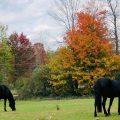You will find a lot of forecasts in the Harrowsmith Almanac, along with all the useful tips and observations on what you should be doing with your plot in the forest as the seasons turn. But we don’t recommend you bet the farm on any of these predictions because the planets have a way of combining in ways that constantly confound us.
Prediction has never been the strong suit of the human species. We get it wrong pretty much 10 times out of 10. But we’re absolutely brilliant at adapting to stuff nobody expected to see in our lifetime. We’re so good at
adapting that there are now something like eight billion of us on the planet.
The almanac is a Spanish invention, although the word itself comes from the Arabic almanach. That’s because people who wanted to sound smart in 13th-century Spain tossed around Arabic words the way we say feng shui or zeitgeist.
King Alphonso the Learned really wanted to know how the universe worked, and he asked the State of the Universe Committee, which had been meeting on the third Thursday of the month for the last century, to give him an interim report. Five years later, the report, weighing 200 pounds, was wheeled into the king’s bedchamber.
The king waded through this volume for a week, pausing only for sleep and prayer, and finally emerged looking very dishevelled and disoriented, and demanded an executive summary of the interim report. “A what?” said the royal steward. “I need an almanach of this bloody thing!” shouted the king. (It was about
this time that people started calling Alphonso “the Learned.”)
The steward looked up the word in his Arabic dictionary and found it simply meant “climate.” So he wheeled
the volume downstairs again and put a team of monks on the project, and they sifted through the report, looking for any observations about the weather. The king died before the almanac finally made it back upstairs, and it was the royal steward who took the almanac home when he retired to his little plot in the country.
Then he handed it around to the family for the rest of his days, until it was dog eared and coffee stained. Versions of the pamphlet eventually made their way to England and Germany, and finally a copy fell into the hands of German printer Johannes Gutenberg, who ground out the first printed edition in 1457, claiming that he had invented it.
It was a hit and helped pay off the expenses of printing his Bible. Gutenberg struggled away for 11 years after that brief triumph with his almanac, but he was never able to buy the little farm near Bamburg that he always wanted. Instead, he had to satisfy himself with a few tubs of coloured carrots outside his workshop because tomatoes had not yet found their way across the Atlantic from the New World. He fell into a decline and was found one morning by his housekeeper with a few vellum pages titled “On the Death of Publishing” clutched in his lifeless fingers.
A sad story, but the almanac survived him and continues in many forms to this day, helping gardeners and farmers everywhere start the day with hope in their hearts and a spring in their step.
We hope you enjoy your copy which can be found on newsstands across Canada from August 5th to March 1st.
To get the digital edition click here
Dan was born in Toronto and raised partly in the city and partly in the country. His mother moved the family out of the city each spring to a hobby farm near Rosemont, Ontario where he and his brothers and sisters tended to a herd of Jersey cows and worked on the neighbouring farms of the 7th Line.












